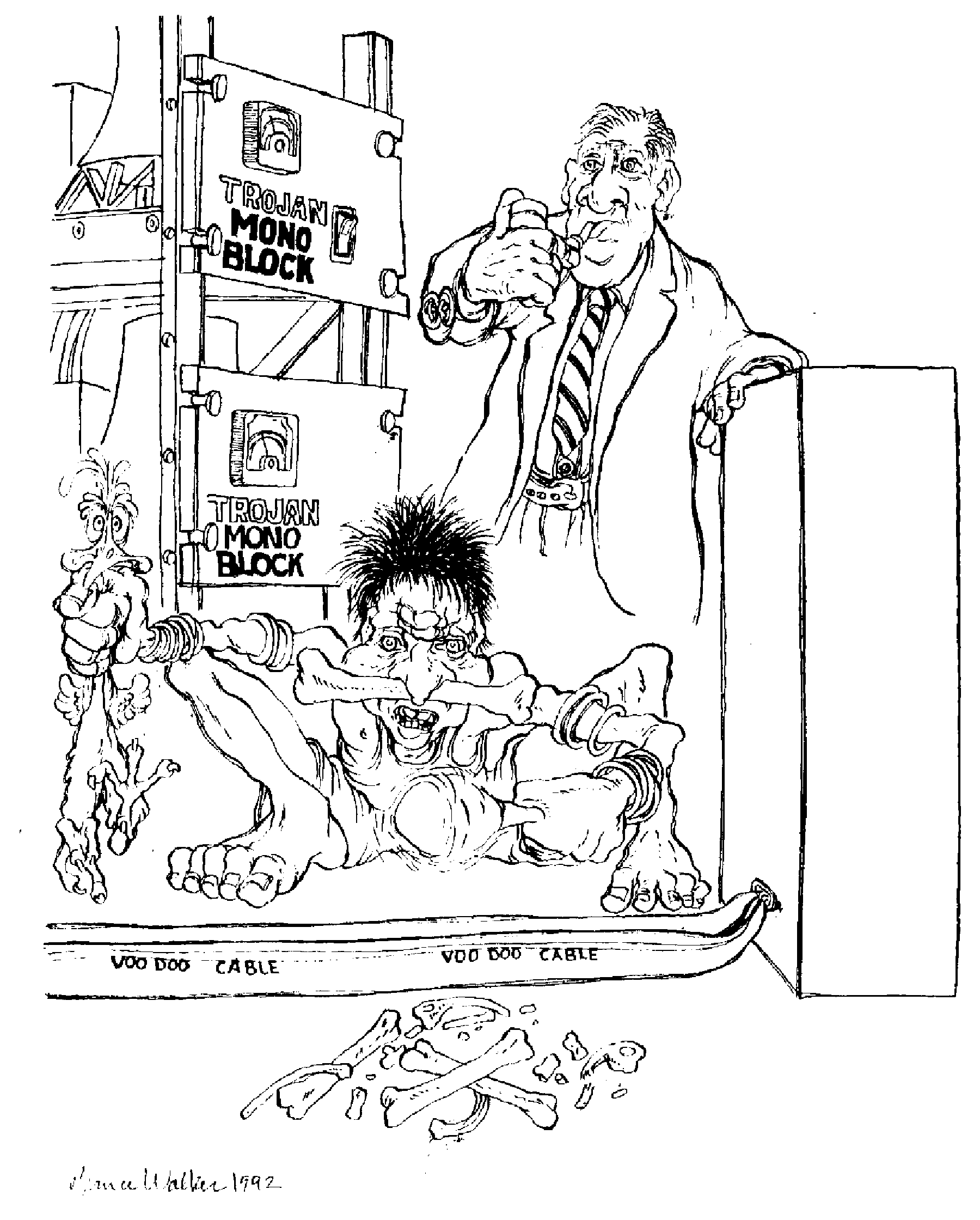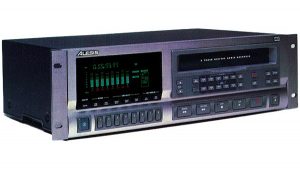
One of the audiophile "tweaks" most often criticized on the internet and in back-room bull sessions is the use of cable lifters to improve system sound. In fact, other than cables, themselves, which are a perennial source of audiophile controversy, there's hardly anything I can think of that gets more consistently negative commentary, with or without real knowledge to back it up. A goodly number of the self-styled "audio gurus" out there apparently decided, long ago, that cable lifters are just too strange not to attack, and they've been gleefully debunking them ever since.
As I recall it, cable lifters were first publicly mentioned sometime back in the late 1980s by Enid Lumley—then a reviewer for the absolute sound—who, in an article for that magazine, claimed that, just by using short lengths of "two-by-four" spaced every few feet to lift her speaker cables off the floor, she had gotten a clear and obvious improvement to the sound of her system.
On reading that, some people trusted her opinion, followed her example, and did the same thing, with claimed good results. Others, perhaps thinking that it was just one more weird "Lumley-ism" (of which there were certainly plenty), dismissed the idea of keeping cables away from the floor without ever even trying it, and the controversy since then has been non-stop.
Over the years, any number of articles (including a couple by me in other publications) have been written on both sides of the cable lifters issue, with its supporters usually trying (but not always successfully) to find some scientific reason to justify their operation, and the nay-sayers most often simply declaring them to be "voodoo," "snake oil," or a violation of "common-sense," and offering no actual explanation at all.
Now, however, somebody has published a video on Facebook—I'm sorry I didn't think to save it at the time, but perhaps you can find it yourself—that seems to cast a whole new light on the subject: It shows actual measurements that not only seem to prove that cable lifters can work, but that indicate (at least part of) a real and believable reason why they do work.
What the video shows (and that you can easily duplicate for yourself, if you wish), is a speaker cable, presumably one of a pair, lying directly on the floor ready to be hooked-up between an amplifier and a speaker system. A man is holding an LCR meter (L for Inductance; C for capacitance; R for resistance), set to read out the capacitance of the cable. To begin, he takes and calls out an initial capacitance reading with the cable still completely flat on the floor. Then he lifts part of it (about a foot [30.48 cm]) off the floor, leaving the rest in place, and takes, shows, and calls out another capacitance reading. Then another, and another, and so on—always lifting about an additional foot at a time, and always leaving something in place to hold the lifted portion of the cable off the floor—until the entire cable has been lifted, read, and called out. As he proceeds, each measurement (the total capacitance reading for the entire cable), starting from the initial one with the cable lying flat, gets lower and lower until the entire cable is off the ground.
What the test shows is that the total capacitance of the cable is not dependent just on its internal and design characteristics, but that it is also affected by its environment—in this case, either the floor upon which it rests, or the air with which it is surrounded—which becomes an effective part of its working dielectric.
Lifting the cable off the floor lowers the cable's total capacitance, which can make a difference to the sound of your system in either or both of two ways: The first way is by directly affecting the frequency response of your speakers.
Unless you're running full-range, single driver speakers, it's almost certain that they have some kind of a crossover network built into them. This may be of almost any level of complexity but, at its very simplest, it will be a single capacitor to provide a six dB per octave "rolloff" below a certain frequency, to keep potentially destructive lower frequencies out of your tweeters. The actual values and frequencies involved depend on a number of factors, including the nominal impedance of the drivers, but in general the rule is that the "bigger" (higher value) the capacitor is, the lower the crossover point will be.
Given the magnitude of the difference in capacitance between a cable fully suspended and one flat on the ground, it's unlikely that the frequency response change will be great (or possibly even audible), but there will certainly be some change.
The other way has to do both with the characteristics of capacitors and the nature of human hearing.
Before going further, though, let me first state what a capacitor is: Very simply, it's a type of energy storage device which is formed, intentionally or not, whenever any two current-carrying conductors are separated by a non-conductor. The two conductors, regardless of their shape, are known as the "plates," and the non-conductive parts (all of the elements that make up the insulation) are called the "dielectric."
That means that speaker cables, with their two signal leads separated by their non-conductive "leg" insulation and held together by their insulating "jackets," don't just have capacitance; they are capacitors, and will act to store and release signal energy just the way any other capacitor would..
That means that as signal energy comes in (call it positive-phase at this point), the bulk of it will pass straight through the cable, as intended, but some small portion of it will be stored in the dielectric and held until the incoming signal energy changes phase (goes from positive to negative). Then, except for a tiny portion of it that will be lost as heat (the dissipation factor or power factor), that stored energy is dumped back into the signal path out-of-phase, to either cancel incoming signal energy, or—depending on the amount of dumped energy compared to the amount of incoming energy—actually create short-term out-of-phase signal artifacts to add false signal information to what we hear. Finally, after all of the stored positive energy is cleared, the dielectric will start storing a portion of the new (now negative phase) incoming signal energy and the process will start all over again, happening twice (once positive and once negative) for each full (positive phase plus negative phase) waveform passed.
NOTE: The above is true for all symmetrical waveforms, like sine waves, for example, but a music signal is NOT symmetrical. Instead, it consists of multiple tones and harmonics at any given instant, all algebraically added together to produce a single very complex waveform that, instead of regularly going from positive to negative and back, may actually go from positive to more or less positive or negative to more or less negative, and may actually change overall phase only occasionally, when all of the additive factors make for it. Dielectric dump cancellations or artifacts in music signal transmission may, therefore, occur less consistently, but are no less deleterious to signal integrity, and, may actually be more noticeable and disruptive.
The amount of energy any capacitor can store is determined by the kind and volume of its dielectric material(s), and on the volume of dielectric material(s) involved. The ability of any dielectric material to store energy for any given volume is called its dielectric constant, and how much total energy can be stored depends on how much of the material there is.
In addition to its dielectric constant, the most important other factor for any dielectric material (at least from the standpoint of audio sound quality) is its dump rate—how fast it can discharge or recharge stored energy. This makes a great difference in perceived sound quality because the faster the stored signal can be dumped and the new storage process started, the less any cancellations or artifacts will be heard. To understand this, consider that at just 10kHz—only half of what's usually described as the "normal range of human hearing", and well within the hearing range of most people, even into their late middle-age—a quarter-waveform, which ought to be clearly audible, is only one forty-thousandth (0.000025) of a second long, and can easily be canceled or replaced by dumped signal energy or an out-of-phase signal artifact lasting just that tiny amount of time. Higher frequencies take even less time and can be lost even quicker, which is why the faster the dump can be accomplished, the less damage it will ever do.
Now, here's where we start the actual process of "bunking" (the opposite of "de-bunking") cable lifters:
Different dielectric materials have different dielectric constants. Air, with a dielectric constant of just 1.0006, (HERE) has (next to a perfect vacuum, at just 1.000), the lowest dielectric constant known. Wood, nylon (as for carpeting), tile, and every other commonly used flooring material all have dielectric constants at least twice as high as air (and often much higher), and all will store and dump at least twice as much potentially signal-corrupting energy.
That means that if, as both theory and measurement indicate, the material a speaker cable is in contact with becomes an effective part of its total dielectric, then it's perfectly reasonable that lifting the cable off the floor and surrounding it on all sides with air should reduce the total amount of signal energy it can store, and later release it to interfere with accurate transmission of your music signal.
Not only does lifting cables off the floor reduce the total dielectric constant of the materials affecting its amount of stored and dumped energy, it also affects its effective dump rate, for better sound.
Even materials of very similar dielectric constants (Teflon® at about 2.0, and Polyethylene at about 2.1, for example) can, and often do, have greatly different effective dump rates, with Teflon being considerably faster than polyethylene. There's no similarity between the dielectric constants of air and any of the common flooring materials, however, so it should come as no surprise that the dump rate of air is far faster. Air, in fact, has both a much lower dielectric constant and a much faster dump rate than any flooring material known, and that should make it your obvious best choice as the material to put under your speaker cables.
Try it. It'll make your system sound better. Enid Lumley wasn't wrong.







































